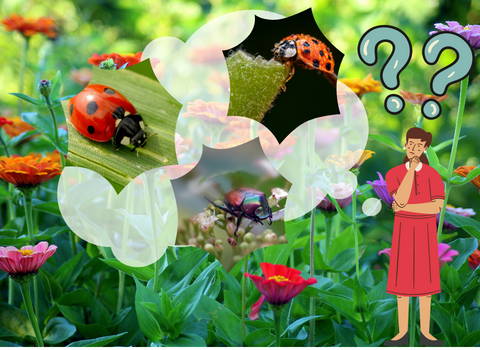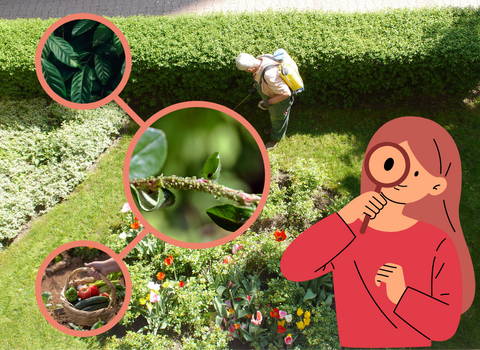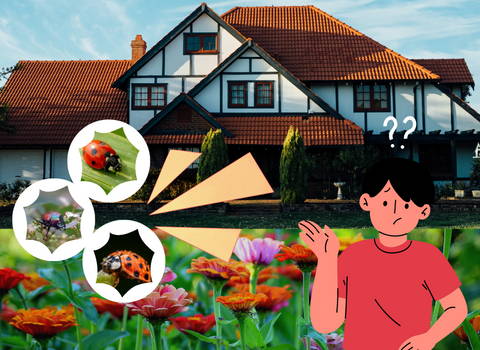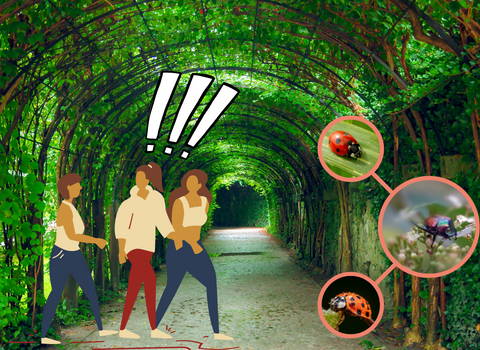Asian Lady Beetle vs Lady Bug vs Japanese Beetle: 4 Differences
People who are not familiar with different insects or beetles may get confused when identifying, ladybugs, Asian lady beetles, and Japanese beetles from each other. However, there are a few key differences that these insects have from one another. These are what we will discuss throughout the article.
Appearance

Asian Lady Beetles
The Asian lady beetle is slightly larger than ladybugs and is a little longer than a ladybug. Ladybugs and Asian lady beetles may have a similar appearance but the colour of Asian beetles ranges from red to orange and may or may not have black spots or dots on their wing covers.
An obvious way to differentiate the appearance of a ladybug vs Asian lady beetle is found on their heads. Asian lady beetles have this black “M” marking on their white head.
This specific marking varies in shape, size, and thickness, but it will always stay in that particular place.
Lady Bug
Ladybugs and Asian ladybeetles may have remarkably similar appearance, but when it comes to colour, ladybugs are bright red and has black spots. A ladybug has a round, oval shape body.
Ladybugs have black heads with small white markings that may resemble cheeks since these are found on the sides of the head. The head of a ladybug is less pointed and shorter than Asian lady beetles.
Japanese Beetles
If ladybugs and Asian lady beetles may look similar, Japanese beetles look vastly different. The colour of the wing coves of these insects is bronze while their body is shiny and has a metallic green colour. Running along its sides are six small hair tufts.
The names of Asian lady beetles and Japanese beetles may sound like similar insects, but these names are not interchangeable, and these insects are in no way similar.
Diet

Asian Lady Beetles
The diet of Asian lady beetle vs ladybug is similar. Asian lady beetles eat aphids and any soft-bodied insects that can cause damage to landscapes, crops, and gardens. This makes them beneficial to gardeners and farmers.
Lady Bug
As mentioned, ladybugs consume aphids that damage crops, fruits, vegetables, and flowers.
Japanese Beetles
Aside from aphids, Japanese beetles are known to feed on over 300 plants, leaves, flowers, overripe, and wounded fruits. They love consuming magnolias, cherries, raspberries, roses, and various fruits with somewhat tough exteriors.
What makes these bugs unwelcome to gardens and farms is that they tend to feed in large groups. They swarm on a plant and start eating it from top to bottom.
Invasive or Not

Asian Lady Beetles
Asian lady beetles invade homes as they prepare to overwinter. They gather in ceilings, attics, and wall spaces as they seek warmth and protection for the winter.
Homeowners that are dealing with an Asian lady beetle infestation reported developing sinus problems and that activities of these beetles trigger minor allergic reactions.
The defensive tactic of Asian lady beetle when they are disturbed is they emit this foul-smelling yellow liquid that can stain walls as well as other surfaces. You might think that these insects are cute, but they do bite.
Lady Bug
The ladybug is considered a beneficial insect. It helps hardeners by eating pests that eat away and destroy plants. They do not cause any form of damage to plants, but they greatly help in keeping pests away.
Japanese Beetles
Unlike ladybugs and Asian lady beetles, Japanese beetles are known to be invasive species that gardeners and farmers try to get rid of for many years. They are known to wreak havoc on plants, crops, and the agricultural industry as a whole.
One way to tell when these bugs are starting to damage your plant leaves is by the distinct leaf-eating pattern that they create. They do not eat the veins, so they will only leave lacy-looking leaves once they are done eating them.
Behaviour and Risk to Humans

Asian Lady Beetles
More beetles tend to sneak into homes and gather in and around homes in winter or fall. At some point, you might think a ladybug pest control is what you need, but in reality, you need to contact a local pest control company for these beetles.
Whenever they feel threatened, they excrete a yellow foul-smelling liquid from their leg joints. This is called “reflex bleeding” and may also happen if they are crushed.
Though the risk level to humans may be low, the self-defence smelly liquid can be harmful to both humans and pets because it may be potentially poisonous and allergenic to humans.
Lady Bug
Ladybugs are harmless insects, but they can pinch and bite when threatened. It may leave a mark, but their bites are not venomous and may only contain mildly toxic properties. Their colours tell potential predators that they are not worth eating and are dangerous.
A ladybug also releases a smelly chemical from their knees that keep its enemies away.
Japanese Beetles
There is no evidence suggesting that they bite humans. However, they will try to pinch you using their mandibles when threatened. Even still, the mandibles are too weak to pierce the human skin.
These are not to be considered other ladybug species as these are scarab species that are invasive and cause too much damage in North America and Western Europe.
Below are some products you can use against Japanese Beetles:

